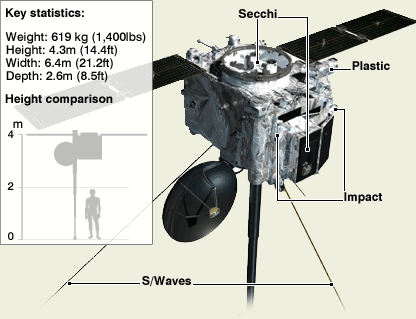STEREO (Solar TErrestrial RElations Observatory)

SECCHI: The Sun-Earth Connection Coronal and Heliospheric Investigation
is a suite of instruments that includes the UK Heliospheric Imager.
Secchi will picture and study coronal mass ejections from their
origin on the Sun to their impact at Earth.
IMPACT: In-situ Measurements of PArticles and CME Transients
is another instrument suite which will measure energetic ions
and electrons accelerated in coronal mass ejections and solar
flares.
PLASTIC: The PLAsma and SupraThermal Ion Composition instrument
will also study CME particles - protons, alpha particles and heavy
ions.
S/Waves: The Stereo/Waves instrument monitors radio disturbances
travelling from Sun to Earth
STEREO (Solar TErrestrial RElations Observatory) consisted of twin NASA spacecraft designed to explore coronal mass ejections (CMEs), the "space weather" to which they give rise, and the potentially serious effects for life on Earth. The $520 million STEREO mission was successfully launched on 26 October 2006 by a Delta II rocket. It is expected to provide new insight into what causes CMEs, and allow scientists to track their progress through space. Other solar-observing spacecraft, such as SOHO, have been unable to tell whether a CME is heading for Earth or away from it. STEREO should give a couple of days' notice that a CME is heading our way.
The STEREO spacecraft carry 16 instruments and are nearly identical. Minor differences include adjustments allowing one unit to fly upside down, to point its antenna at Earth. Timing systems will ensure images are taken by the spacecraft within one second of each other, allowing them to be blended into 3D pictures.
One STEREO observatory will run slightly ahead of Earth in its orbit, taking some 345 days to go around the Sun. Its partner will lag Earth slightly, taking 385 days to go around the Sun. The satellites will also drift further apart each year, widening the angle between themselves and Earth as viewed from the Sun. The mission is expected to last at least two years.


